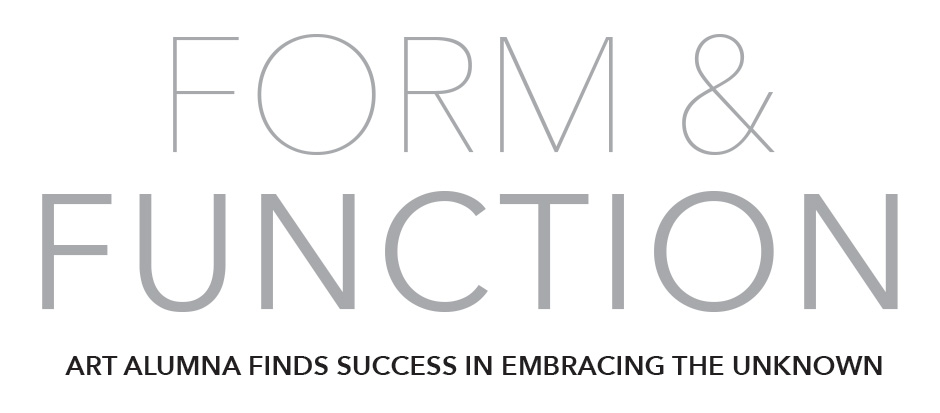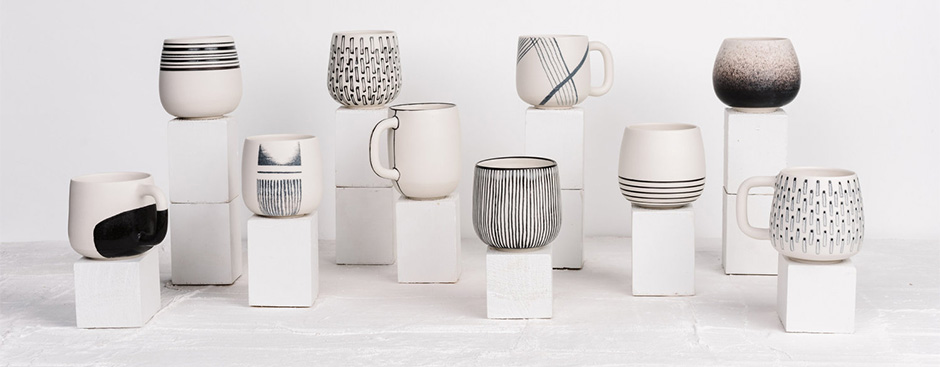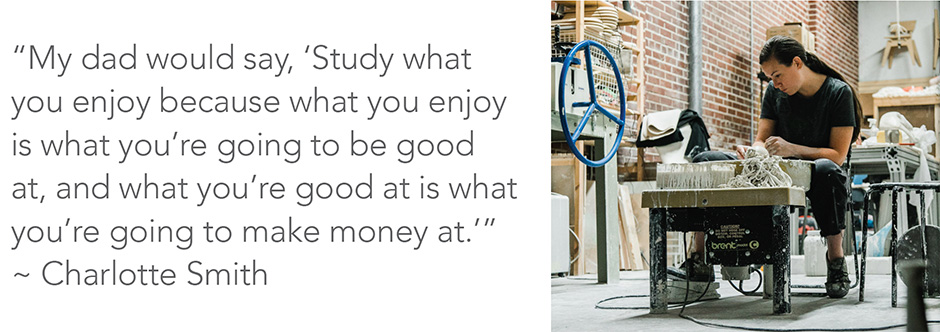
Charlotte Smith needs to make things. It occupies her mind, it occupies her hands, and makes her happy. So, when as a fresh graduate she was still looking for work in her new home city of Atlanta, she decided to join a makerspace.
For a small monthly membership fee, the 2012 fine arts graduate gained access to a creative space equipped with a variety of tools and she soon got busy making cups. Big cups, small cups, patterned or plain—it wasn’t that her cup runneth over, but that her workspace ranneth over with ceramic cups.
Though she chose a sculpture emphasis for her degree from Mississippi State, Smith said there was something freeing about experimenting with ceramics.
“Clay is like the Wild West of materials,” Smith explained. “With wood or metal, you know if you cut it to a length, it’s going to stay that length. But with ceramics, you have to wonder: Is it going to crack? Is it going to blow up? Is the glaze going to turn out right after you’ve spent hours on this piece?”
She said she found the unknowns of the process daunting during her ceramics courses at State, but the challenge of the medium was a good way to expand her creative side when she arrived in Atlanta.


TOP: Charlotte Smith at work in her studio. (Photo by Dennis Johnson) BOTTOM: An array of Smith’s ceramic creations. (Photo by Andrew Johnson)
“The cups became these small pieces that I didn’t have to invest too much time in and could experiment with a lot, so I started developing this style around cups,” Smith said. “Most people wouldn’t describe clay as instant gratification but coming from working on sculptures in school—especially installation-based pieces—making these cups was instant gratification.”
As Smith developed her style, her instant-gratification hobby turned into a near-instant business at the suggestion of an acquaintance who owns a coffee shop.
“She became my first wholesale client,” Smith said. “So, the business just kind of happened.”
In addition to her wholesale ceramics business, Smith sells her wares directly to consumers through the Charlotte Smith Studios website. She also creates custom pieces, like light fixtures, large planters and vases, for individuals and design firms.
“I make mostly functional stuff, and I don’t want the design to take away from it functioning well,” Smith explained. “That’s the thing I enjoy about these pieces—focusing on the form and how that form functions. The design becomes secondary; something to delight while the piece does its job.”
Smith, a graduate of the Mississippi School of the Arts, said she initially considered studying architecture, but her father, a contractor, encouraged her to follow her passion.
“I’m lucky that, even though they might have been skeptical sometimes about how things would work out, my parents were supportive,” Smith explained. “My dad would say, ‘Study what you enjoy because what you enjoy is what you’re going to be good at, and what you’re good at is what you’re going to make money at.’
“When I started taking my foundation courses at State, I realized sculpture was where I needed to be,” Smith continued. “It felt really intuitive and there’s not really any limits to it. You could work with any material and make whatever you wanted, and it allowed me more freedom to express myself.”
She said it helped that Mississippi State’s sculpture program is a “gem.”
“When people ask me what it was like being an art major at Mississippi State, I think they’re surprised when I tell them how great the facilities are,” she said. “Critz Campbell worked really hard to build a nice shop, and I felt really fortunate to have access to all of those tools.”

The sculpture program moved to the Howell building—former longtime home of agricultural and biological engineering—in 2008 just as Smith was enrolling at State. And while Campbell says not many would characterize the aging building as “nice,” its 4,000-square-foot shop space—with an abundance of light, large garage doors and excellent ventilation—makes an excellent studio.
However, Campbell, a professor and head of the art department, said he thinks part of what makes the program special is its focus on the “how.”
“Sculpture students spend much of their time working out how to bring their ideas to fruition,” he said. “The process is direct and less forgiving than digital media, which is a valuable learning experience. I love to tell students there is no delete button for mistakes.
“But ultimately, what makes it a ‘gem’ is the culture of the space,” he continued. “We work hard to create a safe and relaxed environment for students to work with machines and processes they initially fear.”
That’s a mindset that undoubtedly helped push Smith to challenge herself both in experimenting with ceramics and her decision to move from her hometown of Brandon to Atlanta with no sure job prospects.
“I didn’t have much of a plan in terms of where I wanted to work, but I knew in Atlanta, there were galleries, museums and artists I could potentially work under,” she recalled. “The economy still wasn’t great, but it seemed like there would be more opportunities in a bigger city, so it seemed like a good gamble.”
Now, with a successful career doing what she loves, it’s safe to say trusting her intuition has paid off.
“Charlotte is a unique, multi-talented artist,” Campbell said. “Her drawing and design skills are equally as impressive as her skills in sculpture and ceramics. She has an instinct for proportion and form that takes many artists years to develop. I am so proud and impressed by the creative life she has carved out for herself.
“It’s always a joy to see students use their talents and education to build exceptional and creative lives,” he continued. “Their success feeds the students who come after and reminds faculty of their importance in the process.”

By Susan Lassetter | Photos submitted
